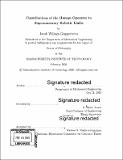| dc.contributor.advisor | H. Harry Asada. | en_US |
| dc.contributor.author | Guggenheim, Jacob(Jacob William) | en_US |
| dc.contributor.other | Massachusetts Institute of Technology. Department of Mechanical Engineering. | en_US |
| dc.date.accessioned | 2020-05-26T23:14:31Z | |
| dc.date.available | 2020-05-26T23:14:31Z | |
| dc.date.copyright | 2020 | en_US |
| dc.date.issued | 2020 | en_US |
| dc.identifier.uri | https://hdl.handle.net/1721.1/125477 | |
| dc.description | Thesis: Ph. D., Massachusetts Institute of Technology, Department of Mechanical Engineering, 2020 | en_US |
| dc.description | Cataloged from PDF version of thesis. | en_US |
| dc.description | Includes bibliographical references (pages 99-103). | en_US |
| dc.description.abstract | An expanding literature base has applied Supernumerary Robotic Limbs (Superlimbs) to fields as diverse as heavy industry, robotic surgery, and assistive technology. While the list of applications has grown, and the designs have become more diverse, the research community has focused almost exclusively on the robotic system's role in augmenting the humans capabilities. This represents only one side of the issue; little research has explored the role of the human operator. This thesis represents the first in-depth exploration of the humans contributions to the Superlimb-human system. We began by examining the control strategy of Superlimbs by asking whether fully manual control of the Superlimbs was viable when the human operator was asked to perform simultaneous and independent tasks with both their robotic and natural limbs. | en_US |
| dc.description.abstract | Although we found that the human operator was able to control all four limbs-two robotic, two natural-simultaneously, we found that the human operator performed worse with their natural limbs when controlling all four limbs as compared to when the human operator was only controlling their natural limbs. Thus, when designing Superlimbs for a task set that requires the human and the robot to perform simultaneous independent tasks, this study points to the need for reducing the number of Superlimb degrees of freedom (DOFs) the human must manually control either through design or control. In order to achieve this reduction, we next exploited the high redundancy and flexibility of the human body. First, we proposed a methodology for reduced-actuator Superlimbs by exploiting the human operators' ability to manipulate the base of the Superlimb. | en_US |
| dc.description.abstract | Based upon this methodology, we realized a lightweight Superlimb that could assist a human operator by opening a door when the human operator's hands are busy. Second, we proposed a novel control input methodology for communicating a rich variety of commands to the Superlimbs while both hands are busy. Based upon this methodology, and in combination with an intermittent control structure, we controlled the reduced-actuator Superlimb described above with action primitives to assist a human operator by opening a door when the human operator was holding a large box. Finally, as the Superlimb's state changes, that change is reflected as a change in the forces and torques felt by the human operator at the base of the Superlimb. We found that this inherent haptic feedback allowed the operator to both perform closed-loop manually control of the force output of a Superlimb and to supervise the autonomous actions of a Superlimb. | en_US |
| dc.description.abstract | In sum, this thesis explores how Superlimbs can be designed to exploit the benefits while limiting the challenges of being attached to a human operator. | en_US |
| dc.description.statementofresponsibility | by Jacob William Guggenheim. | en_US |
| dc.format.extent | 103 pages | en_US |
| dc.language.iso | eng | en_US |
| dc.publisher | Massachusetts Institute of Technology | en_US |
| dc.rights | MIT theses are protected by copyright. They may be viewed, downloaded, or printed from this source but further reproduction or distribution in any format is prohibited without written permission. | en_US |
| dc.rights.uri | http://dspace.mit.edu/handle/1721.1/7582 | en_US |
| dc.subject | Mechanical Engineering. | en_US |
| dc.title | Contributions of the human operator to supernumerary robotic limbs | en_US |
| dc.type | Thesis | en_US |
| dc.description.degree | Ph. D. | en_US |
| dc.contributor.department | Massachusetts Institute of Technology. Department of Mechanical Engineering | en_US |
| dc.identifier.oclc | 1155111599 | en_US |
| dc.description.collection | Ph.D. Massachusetts Institute of Technology, Department of Mechanical Engineering | en_US |
| dspace.imported | 2020-05-26T23:14:31Z | en_US |
| mit.thesis.degree | Doctoral | en_US |
| mit.thesis.department | MechE | en_US |
